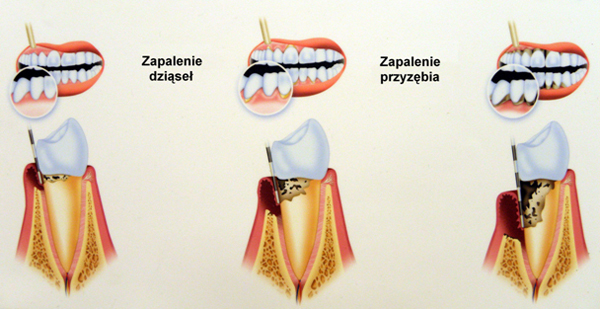Why is it worth removing scale and sediment?
Dentysta stomatolog Warszawa Ursynów ADENTIS / Information and advice / Dental advice / Why is it worth removing scale and sediment?

Due to too short or improper cleaning of teeth, the bacteria that remain on their surface form an initially imperceptible soft deposit called dental plaque. Due to the high activity of bacteria and the rough surface of the nail plate, its number increases quickly. After about 48 hours, the plaque becomes hard and cannot be removed by brushing. Repeating the above-mentioned cycle every day leads to the formation of visible scale deposits.
Stages of the harmful effects of tartar

1. At first, the tartar destroys the tooth
Bacteria present in tartar produce acids that destroy the protective layer of the tooth (enamel) and lead to the formation of caries.
2. The disease process is transferred to the gums
In addition to mechanical irritation of the gums (pressure, rough surface), bacteria destroy the gums through the chemical substances they produce. Inflammation occurs – the gum is red, swollen, bleeds when brushing, and there is an unpleasant breath odor.
3. The stone destroys the bone
The tartar, the mass of which is constantly increasing, surrounds the tooth and moves towards the root tip. By squeezing like a wedge between the tooth root and the bone, it destroys the ligaments connecting these tissues and the bone itself. As a result, the tooth becomes loose and is lost.
| Inflammation of the gums caused by bacterial plaque |
Healthy gums are pale pink in color, completely fill the spaces between the teeth and do not bleed when touched. There is no plaque on the teeth.
Affected gums are red, swollen and bleed easily when touched. The teeth are covered with colorless plaque.
What is gingivitis?
Gingivitis and periodontitis (the tissue supporting the tooth) are diseases that are most often caused by ourselves. Healthy gums never bleed. If your gums bleed while brushing, this is the first sign of gum inflammation. Up to this point, gingivitis is painless, so we often do not notice the problem. If we don’t notice the irritation, the gums will start to recede. The tissue connecting the teeth with the gums is damaged and a space is created in this place. If we do not take any action, the inflammation will go deeper and deeper until the teeth completely lose their hold and begin to fall out.
If the inflammation continues, it may affect the bone and even slowly lead to its loss. Periodontitis can develop without visible signs. These can be:
- changes in tooth position
- “lengthening” of teeth and their loosening
- bad breath
What is dental plaque?
Microorganisms (bacteria and fungi) develop in the warm and moist environment of the oral cavity, feeding on sugar and other substances contained in food remains. Some of these microorganisms cover tooth surfaces and interdental spaces, forming dental plaque. Bacteria convert sugars into acids, which damage teeth and cause tooth decay. Plaque accumulates most abundantly on the edges of the gums and in the spaces between the teeth, i.e. in places that are difficult to reach with a toothbrush.
How to recognize dental plaque?
You can feel plaque with your tongue on uncleaned teeth. The bacteria contained in plaque can lead to gingivitis – healthy gums never bleed. How can you stop the development of dental plaque?
Very easy – by removing it daily. But note: dental plaque can only be removed mechanically. Dental plaque cannot be simply washed away. You can use special tablets or liquid that color the plaque so that it becomes visible. This allows you to easily identify places that need cleaning. Removing dental plaque should be carried out using preparations containing fluoride, which allow the repair of the first damage and prevent further deterioration of tooth health. Even if we remove the plaque mechanically, it starts to settle again after a few hours – bacteria multiply very quickly! Particular attention should be paid to the fact that frequent consumption of sweet snacks between meals destroys teeth. The constant supply of sugar is an excellent breeding ground for bacteria that can produce acids all the time, not giving the teeth a chance to regenerate and remineralize. It is less harmful to consume the same amount of sugar in one sitting because the acid attack is followed by a regeneration phase thanks to the remineralization of the teeth by the minerals contained in saliva.
What is periodontitis?

Periodontitis is a bacterial infection of the tissues that support the teeth. Even a healthy mouth is inhabited by over 300 species of bacteria, most of which are harmless to our health. When the number of bacteria in the oral cavity increases due to inadequate hygiene and dangerous species multiply or the body’s immune system weakens, gingivitis and later periodontitis occur. The main cause is always the accumulation of bacteria on tooth surfaces in the form of dental plaque. Toxins – a product of bacterial metabolism – penetrate deep into the gums, triggering reactions of the human defense system. Inflammation occurs and as a result, the so-called gum pockets.
Control visits for adults should take place every 6 months. Then we remove tartar, plaque and plaque (through preventive treatments, i.e. scaling, sandblasting, polishing).No one brushes their teeth perfectly. After 3 days, the bacterial plaque that accumulates may calcify and form tartar – the biggest enemy of bones and teeth. Tartar can lead to inflammation of the gums, and if the disease is left untreated for a long time, it turns into periodontitis – the system that holds the tooth in the gum and leads to loosening of the teeth (commonly called periodontitis).
Dr Aleksandra Gabren

